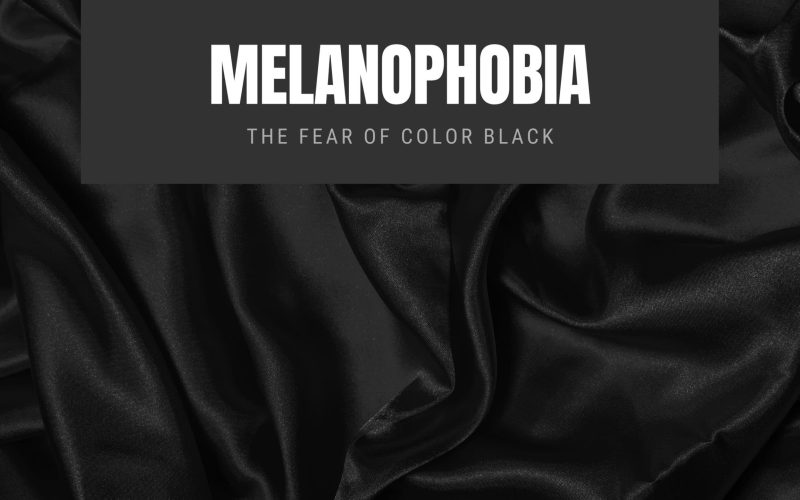Phobias are a very common issue people deal with, and if you have one, accepting it is the first step to conquering it.
Are you afraid of the dark, hate the color black, believe that black is a superstitious color, or that black reminds you of mourning or sadness?
Then you are definitely melanophobic. Melanophobia is coined from the Greek word “Melano,” which means Black, and “Phobia,” which means fear.
Melanophobia is the fear of blacks. Melanophobics tend to avoid black, which is quite impossible as they would have to see the color black daily.
This is related to Chromatophobia or chromophobia, which is the fear of Colors. Most people with melanophobia tend to be Negrophobic. Negrophobia is the fear of Black people.
People with this phobia might also have Achuluphobia (Fear of the dark). This also connotes that most Melanophobics are racist.
The color black is usually associated with death, Satan, mourning, sadness, grief, plague, darkness, bad experiences, or dirt.
People must realize that they give life to their fear, mostly mere superstitions, unreal hallucinations, and mostly figments of their imaginations.
They should also know that these fears are not above their control. Melanophobics experience anxiety when exposed to the color black.
Symptoms of Melanophobia
These Melanophobics get to unavoidably see black daily, ranging from black cars to black clothing.
Below are some of the symptoms that they would experience:
- They get very nervous when they think of the color black.
- They experience anxiety when they see the color black
- They are always afraid to go out in the night
- They are always scared of dark places
- They may have panic attacks when they encounter black color
- They may hyperventilate at the sight of the color black
- Inability to cope with their anxiety
- They tend to hallucinate when in dark places
- They may cry or scream if they find themselves in the dark.
Causes of Melanophobia
The causes or triggers of melanophobia may be direct or indirect. Below are some of the triggers:
- Parental or societal influence: Some Melanophobics are raised by people who hate the black color, and this, in every way possible, contributes to their hatred for the color black. Also, in a society where black or black people are hated, then the number of Melanophobics is going to be high. Furthermore, culture is a subdivision of societal effects. In some cultures, black is seen as a representation of evil deeds. They also have legends and folktales to back them up. These go a long way in fueling the hatred for the color black.
- Genetics: As weird as it seems, these fearful Melanophobics genes can be inherited from parents or even ancestors. Sorry, lovers of black, as you’ve got to look out for Melanophobics when choosing a life partner. You don’t want your offspring inheriting hatred from your favorite color or your spouse getting afraid at the sight of black.
- Traumatic Past Experience: If a person had a bad experience involving black, that person would become fearful of the color black over time.
Treatment for Melanophobia
People who are Melanophobic most often don’t seek treatment as they try to avoid black colors and dark places. They also avoid going out at night.
Some also feel they have some control over the influence of the color black. Avoidance of black at some point is definitely not enough. Therefore, they must seek treatment.
Most treatments for phobias are very similar, although the workability depends on the individuals involved and the level of severity of their fear.
Below are some of the procedures for treating Melanophobics patients:
1. Self-care
In this case, the Melanophobic individual makes attempts to help himself or herself out of the situation (phobia).
In self-care, the Melanophobic patient tries to build self-confidence, live healthily, avoid a Sedentary lifestyle, give pep talks to oneself, spread positive energy, make and affirm positive declarations, build confidence, build Healthy self-esteem, engage in more and better social activities, seek therapy, etc.
2. Desensitization
Desensitization is a behavior reformation technique used especially in treating phobias, in which panic or other undesirable emotional responses to a given stimulus are reduced or extinguished, especially by repeated exposure.
In other words, this self-performed technique is used to unlearn wrong notions and replace them (relearn) the right ones. It can help an individual completely get rid of melanophobia.
3. Exposure Therapy
Exposure therapy is one of the best ways to treat anxiety disorders. It helps in the desensitization of Phobic individuals.
It is a gradual process as it is conducted step by step with the help of a psychiatric counselor or a psychotherapist.
In this, the phobic patient is gradually exposed to the trigger or gradually introduced from the model of the trigger to the main trigger.
Eventually, the patient understands the reality of his phobia in a harm-free experience.
4. Exercising
Physical fitness goes a long way in getting rid of panic attacks. Cardiovascular and aerobic exercises are encouraged in this case as they help reduce panic attack symptoms.
Aerobic exercises include running, jogging, swimming, etc., and they help to relax tensed muscles. It encourages the body to release endorphins – the happy hormone.
5. Meditation and yoga
Meditation can never be overemphasized in the act of better living. It helps to clear the mind of unnecessary life cares, increase productivity and efficiency, decrease physical and emotional effects of stress etc.
It helps people who are Melanophobic to focus their attention on what is important and not on life problems.
Yoga focuses on harmonizing the body and the mind. Yoga increases muscle strength and tone, eliminating the fatigue that Melanophobics could experience.
It also improves respiration, energy, and vitality, alleviating breathlessness and reducing panic attacks. It also helps maintain a balanced metabolism and cardio and circulatory health. It also reduces the tendency to fall into depression.
6. Psychiatric medications
- Use of Anti-anxiety meds: Due to panic attacks experienced by Melanophobics, some Anti-anxiety medications recommended include Xanax, Valium, Klonopin, etc. These drugs are not to be taken daily or abused when the phobia is not severe. Your healthcare provider should be consulted before the purchase and consumption of these drugs to avoid abuse and also to get qualified recommendations.
- Use of Anti-depressants: Anti-depressants are not only taken by people who experience depression, but also it is taken by people who experience Panic attacks. It helps to reduce the symptoms of the melanophobia. Recommended Anti-depressants include Paxil, Zoloft, Lexapro, etc. These drugs are not to be taken daily or abused when the phobia is not severe. Your healthcare provider should be consulted before the purchase and consumption of these drugs to avoid abuse and also to get a qualified recommendation.
Also, as Anti-depressants, these drugs, when abused, could cause similar effects to panic attacks such as nausea, vomiting, blurred vision, fatigue and drowsiness, insomnia, dry mouth, etc.
Conclusion
Your fears are not beyond your control. Try to seek help when it’s early, and If you know anyone around you with a severe phobia that affects their day-to-day activities, then help them find the help they need.
As much as the professionals are trained to help you with your phobias, that cannot be fully achieved without your cooperation and support.
Also, try to involve family members and friends when you feel your phobia is getting beyond your control or worse.
This is because their encouragement and support go a long way in helping to get rid of a phobia. We hope that you have benefited from this article.
If yes, kindly leave unbiased comments and suggestions below. Also, remember to look out for other phobias here to learn more about them. We look forward to hearing from you.








